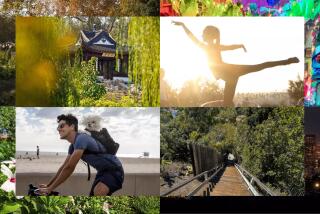Giving local artists a good first shot
- Share via
A tiny art competition that has been gearing up behind the scenes for the past year will put a spotlight on emerging artists and Southern California art schools. The project, LA25, has teamed up some of the Los Angeles art world’s heavy hitters, including Harold M. Williams, president emeritus of the J. Paul Getty Trust, along with the UCLA Hammer Museum, which will present an exhibition of the winners’ works in 2008.
“We thought we should do something in relation to the arts, to recognize the role they play in making a community livable and enjoyable,” said Williams, of Skadden, Arps, Slate, Meagher & Flom LLP & Affiliates, a law firm that is sponsoring the project to celebrate the 25th anniversary of its L.A. office. “This is really a very dynamic arts community with all the art schools and all the young artists.”
LA25 is a work in progress, but it is shaping up as a three-year program that will honor 25 artists, selected by a jury of art professionals. In the first round of the competition, jurors chose nine photographers. The next two installments, in 2007 and 2008, will be open to artists who work in a broad range of media. Exhibitions of the winners’ work will be staged in Skadden’s downtown offices and in yet-to-be-designated public spaces during the next two years, as well as at the Hammer in 2008.
Beginning today, this year’s winners will appear on www.Skadden.com, the law firm’s website. Online visitors can see examples of photography by Patterson Beckwith, Matthew Jordan, Jose Alvaro Perdices and Brenna Youngblood of UCLA; Elad Lassry and Natalie Shriver of USC; Whitney Stolich of Otis College of Art and Design; Jeff Sheng of UC Irvine; and Lee Thompson of UC Riverside.
“What’s interesting to me is that the other people selected are incredibly strong artists,” Sheng said. “It’s a wonderful thing to be recognized with peers you really respect and admire.”
The work encompasses a variety of subjects and approaches. Sheng, who has photographed gay athletes on high school and college sports teams, is working on panoramic tableaux that grapple with the notion of memory. Lassry investigates computer-generated and digitally manipulated photography, sometimes pairing similar images. Youngblood blends photography, painting and collage in expansive cityscapes. Shriver investigates what can be seen in a photograph and what can only be intimated.
The artist selection process began more than a year ago with a conversation between Williams and Hammer director Ann Philbin. Williams was looking for a curator to take charge of LA25. Philbin recommended Ilene Kurtz-Kretzschmar, an art adviser and publisher who has organized many artist projects in New York and was preparing to move to Los Angeles.
“I was very excited about what’s happened in Los Angeles,” Kurtz-Kretzschmar said. “Much of that has to do with the great art schools. In the past, artists who went to those schools left and went to New York. Now they are staying, and there is gallery support and museum support. That was interesting to me and to Skadden.”
She visited 85 studios, drew up a list of 26 finalists and assembled a jury composed of Philbin; Kris Kuramitsu, an independent curator; Paul Schimmel, chief curator at the Museum of Contemporary Art; Weston Naef, curator of photographs at the J. Paul Getty Museum; and artists John Baldessari and Cathy Opie. Eungie Joo, gallery director and curator at REDCAT, will join them in 2007; she was unavailable this year.
Initially, the plan was to limit the entire project to photographers enrolled in master of fine arts programs and to reproduce their work in an anniversary portfolio published by Skadden. But that proved too restrictive, Kurtz-Kretzschmar said. Many artists working with photographic processes are primarily involved with video; others incorporate photography in multimedia works. To broaden the field, she included some recent graduates from local art schools and considered changing the guidelines.
“As we moved along in the process, we decided to open it up,” she said. “I found so many artists I was interested in who were not working with photography. We were eliminating some extremely interesting talent.”
They also decided to drop the portfolio.
“We didn’t want that to lock us in,” she said. “The focus is supporting young, emerging artists and the schools. A more open approach is a more interesting way to do that.”
The point, Williams said, is to “give visibility to emerging artists” and “help kick-start their careers.” Plans to purchase their work are under discussion, as is the exhibition program.
“We are looking at ways to do public exhibitions before the 25th anniversary show at the Hammer,” he said. “But what we do and where we do it is still in the cooker.”
More to Read
The biggest entertainment stories
Get our big stories about Hollywood, film, television, music, arts, culture and more right in your inbox as soon as they publish.
You may occasionally receive promotional content from the Los Angeles Times.










